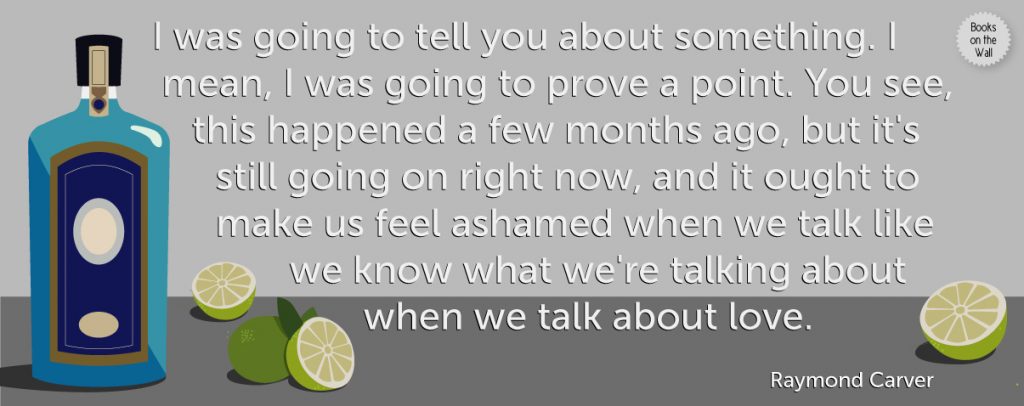Raymond Carver: What We Talk About When We Talk About Love

We’ve all seen the supermarket flowers, the balloons, the heart-shaped chocolate boxes and giant overfluffed plush animals. Yep, it’s almost Valentine’s Day! We thought we’d celebrate the upcoming holiday with a fitting title from one of America’s most renowned short story writers, Raymond Carver’s “What We Talk About When We Talk About Love.”
“What We Talk About When We Talk About Love”
Though the title makes this story sound like an obvious choice for Valentine’s Day, the reality of the text is a little more complex. The prose is clean and direct (like most of Carver’s work) and its setting and characters static, but the topics of conversation are heavy and full of inner conflict. Like the truest of real-life loves, “What We Talk About When We Talk About Love” is difficult, but it’s worth working through, examining and repeating.
“What We Talk About When We Talk About Love” refers to both a single short story by Raymond Carver and the collection of short stories in which it is housed. This short story may not exude romanticism, but it is a profound and illuminating look at everyday humanity and the subjective nature of love—which we think makes it the perfect love story.
Plot Summary
In the short story, the entire plot takes place at a kitchen table in Albuquerque, New Mexico. Four friends—Mel and his second wife, Terri, and the narrator Nick and his wife, Laura—sit together drinking gin and tonics and, of course, talking about love.
Terri describes her abusive ex, Ed, who eventually killed himself, while Mel speaks of an elderly couple who came to his hospital after a car crash. The discussion meanders, interrupted periodically by talk of going out to eat, of finishing the gin, and of knights and vassals. Mel decides he wants to call his children but changes his mind when Terri points out that his ex-wife might answer the phone. From this point, Mel descends into a depressive episode, fixating on his ex-wife and half-joking about killing her with bees. The room goes dark, the empty gin bottle sits at the table, and though they’ve decided to go out to eat, no one moves.
Meaning
Throughout the conversation, the characters’ definitions and perceptions of love differ from one another. Terri views Ed’s suicide as an act of love, which she mirrors by sitting with him as he dies in the hospital. Mel disagrees, saying that Ed was dangerous, not loving. Though Nick and Laura seem to know what love is, they can’t define it or explain it.
The characters spend the whole evening talking about love, but they never come to an agreement about what love is, how it manifests, or who has it. In the end, the conversation disappears along with the gin and the sun, as if there simply are no words to use to talk about love.
So what do we talk about when we talk about love? With the silly derailment of the conversation to the topic to knighthood and then the halting of the conversation altogether, Carver seems to suggest that to talk about love is to end up talking about nothing. But that doesn’t mean that love is nothing.
In fact, “What We Talk About When We Talk About Love” implies just the opposite. In this story, Carver shows that love (or people’s idea of love) is central to everything, the good but especially the bad. Love is the force that kept Terri with Ed despite his beatings, the force that made Ed shoot himself in the mouth, the force that kept the elderly man alive but also made him grieve, the force that brought Mel together with his ex-wife, the force that makes Mel long for his children, and in its own way, the force that keeps these friends and couples together.
“Beginners”
“What do any of us really know about love?” Mel said. “It seems to me we’re just beginners at love.”
One of the most interesting stories to come out in recent literary history revolves around the editing and publication of What We Talk About When We Talk About Love. Carver’s original manuscript titled “Beginners” differed greatly from what ended up being published as the short story collection, What We Talk About When We Talk About Love.
Carver’s editor, Gordon Lish, made several significant changes to Carver’s original short story manuscripts. In the short story “What We Talk About When We Talk About Love,” Lish cut the text nearly in half, rewrote the situation of the elderly couple in the car crash and introduced a great deal of profanity. Despite critical acclaim of the heavily edited work, Carver protested and resented Lish’s edits. He even considered retracting his stories rather than publish works he did not recognize.
In 1988, Carver published a collection of his original works, before edits, titled Where I’m Calling From. Carver’s widow published another collection of his unedited works in 2009, aptly titled Beginners.
Read a draft of Beginners, as originally intended by Carver, from The New Yorker. The New York Times also offers a more in-depth, side-by-side comparison of passages from Carver’s original and published short story collection.
Birdman
Raymond Carver’s short story ” What We Talk About When We Talk About Love” has re-entered the public sphere recently due to its role in the critically acclaimed film Birdman.
Directed by Alejandro González Iñárritu, Birdman follows Riggan Thomson, a washed-up actor known for his early roles as the superhero Birdman. In an attempt to revamp his acting career and rekindle his artistic pursuits, Thomson decides to direct and star in a play inspired by What We Talk About When We Talk About Love.
However, as Jonathan Leaf points out, Birdman uses the highly edited version of “What We Talk About When We Talk About Love,” capitalizing on the “vulgarity and melodrama” that Lish introduced against Carver’s intent.
—
If you haven’t gotten enough of this short story, listen to the only known recording of Raymond Carver himself reading “What We Talk About When We Talk About Love.”





Leave a Reply
Be the First to Comment!